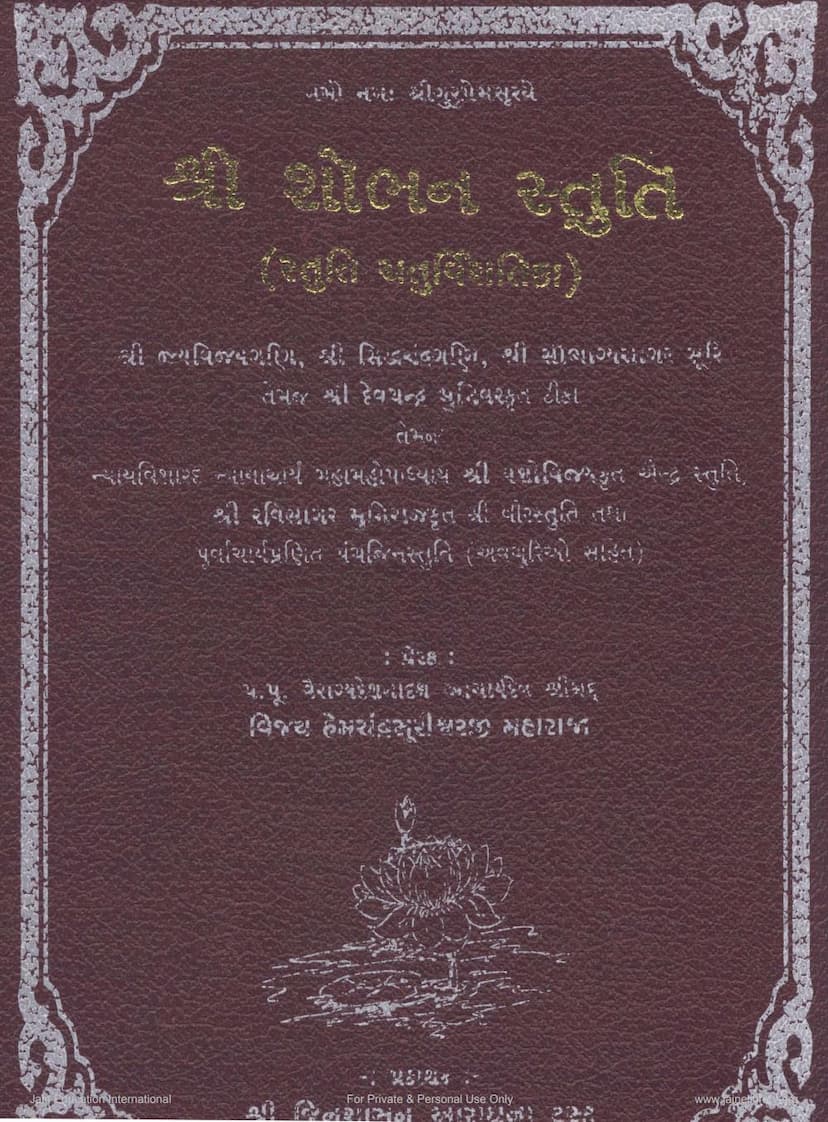Shobhan Stuti
Added to library: September 2, 2025

Summary
Based on the provided Gujarati text, here's a comprehensive summary of the "Shobhan Stuti" book:
Book Title: Shobhan Stuti (also referred to as Stuti Chaturvinshtika, meaning a collection of twenty-four hymns) Author: Mahakavi Shobhan Muni (though the text also mentions contributions and commentaries from various other Acharyas and scholars). Publisher: Jinshasan Aradhana Trust, Patan (Gujarat). Catalog Link: https://jainqq.org/explore/004895/1
Overall Summary:
The book "Shobhan Stuti" is a significant Jain text comprising twenty-four hymns, each dedicated to one of the twenty-four Tirthankaras. The hymns are renowned for their poetic brilliance, intricate use of Sanskrit language, and deep devotional sentiment. The text is presented in Gujarati and includes extensive scholarly work, particularly commentary and analysis, by Professor Hiralal Rasikdas Kapadia, who served as the editor. The book is a re-publication, aiming to make this ancient and valuable work accessible to the wider Jain community.
Key Aspects and Content:
-
The Core Text: Shobhan Stuti (Stuti Chaturvinshtika):
- Composed by the Mahakavi Shobhan Muni.
- The hymns are characterized by:
- Scholarly Depth: Demonstrates a strong command of the Sanskrit language.
- Devotional Essence: Filled with profound Bhakti Rasa (devotional emotion) that resonates with the heart.
- Poetic Excellence: Employs various meters (chhandas) and figures of speech (alankaras), including intricate wordplay like Yamaka (alliteration) and Anupras (assonance), making them technically remarkable and spiritually uplifting.
- Praise for Tirthankaras: Each hymn likely focuses on the virtues and glory of a specific Tirthankara, although the provided text focuses more on the commentary and historical context.
-
Extensive Commentaries and Contributions:
- The book includes commentaries (Tika) from several esteemed Jain scholars and monks:
- Shri Jayavijaygani
- Shri Siddhachandragani
- Shri Saubhagya Sagar Suri
- Shri Devachandra Munivar
- It also includes other significant stutis:
- Aindra Stuti by Mahamahopadhyay Yashovijayji.
- Shri Veer Stuti by Shri Ravishagar Muniraj.
- Panch Jin Stuti (Five Jin Stutis) compiled by earlier Acharyas, complete with their commentaries (Avashuri).
- The book includes commentaries (Tika) from several esteemed Jain scholars and monks:
-
Editorial and Publication Details:
- Editor: Professor Hiralal Rasikdas Kapadia (M.A.) undertook the extensive research, editing, clarification, and detailed exposition of these ancient texts, showcasing immense Shruta Bhakti (devotion to scriptural knowledge).
- Publisher: Shri Jinshasan Aradhana Trust, Patan (U. Gujarat).
- Inspiration/Patronage: The publication was inspired by the teachings of HH Acharya Dev Shrimad Vijay Hemchandrasurishwarji Maharaj and supported by trusts and organizations like Shri Babulal C. Jarivala Charitable Trust, Vadodara, and Shri Adinath Jain Sangha.
- Re-publication Effort: The publication is highlighted as a crucial effort in restoring and making accessible ancient Jain texts that might otherwise become lost or rare. This aligns with the ongoing mission of the Jinshasan Aradhana Trust to reprint and preserve 275 such volumes.
-
Historical and Literary Context:
- The preface (Kishchit Prastavik) provides a valuable introduction to the "Shobhan Stuti," praising its unique combination of scholarly depth and devotional fervor.
- It draws a parallel between the study of secular Sanskrit poetry (like Naishadh and Kirata) and Jain poetry, emphasizing that Jain literature is rich with excellent works like Tilakmanjari, Hirsaubhagyasuri, Rishabhpanchasika, Bhaktamar, Kalyanmandira, and the present Shobhan Stuti.
- A significant portion of the text (pages 18-32) is dedicated to a biographical sketch of Mahakavi Shobhan Muni, meticulously researched by the editor. It delves into his likely origins, his conversion from Brahmanism to Jainism, his brother Dhanpal, the influence of King Bhoj, his guru Mahendrasuri, and the historical details surrounding his life and the composition of his works. The editor meticulously addresses differing opinions found in various historical texts regarding Shobhan Muni's life.
- The text also provides context on the prevalence of complex poetic structures like Yamaka (alliteration) in Jain Sanskrit literature, citing numerous examples from other Jain works to demonstrate this tradition. This section highlights the linguistic artistry and dedication of Jain scholars in preserving and elaborating upon these compositions.
-
The Legacy of Shobhan Muni:
- Shobhan Muni is presented as a naturally gifted poet whose single surviving work, "Nistuuti Chaturvinshatika" (Shobhan Stuti), is sufficient to establish his greatness.
- His life is described as cut short at a young age, suggesting that he might have produced even more magnificent literary treasures had he lived longer.
- The editor, Professor Kapadia, highlights the importance of preserving such rare and valuable texts for future generations, emphasizing the duty of the current generation to continue the stream of knowledge (Shrutdhara) passed down by their ancestors.
-
Detailed List of Published Works:
- Pages 32-41 provide an extensive catalog of books published by the Shri Jinshasan Aradhana Trust, Mumbai. This list includes a wide range of Jain religious and philosophical texts, highlighting the trust's commitment to scriptural revival. The "Shobhan Stuti" is listed as item #279.
In essence, "Shobhan Stuti" is not just a collection of devotional hymns but a testament to the rich literary and spiritual heritage of Jainism, meticulously revived and presented by modern scholars for the benefit of the community. The book is a blend of ancient poetry, profound philosophy, and detailed historical and linguistic research.